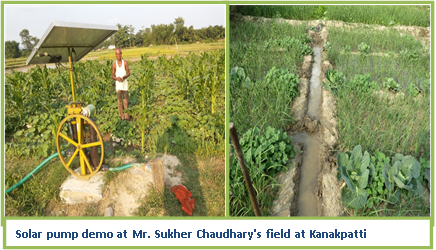iDE Nepal, implementing partner of “Improving water use for dry season agriculture by marginal and tenant farmer project ( ACIAR-LWR project)” in Nepal has been creating a clean irrigation solution that enables millions of smallholder farmers to grow high value vegetables and increase their incomes. As part of this, iDE is introducing an efficient and cost-effective solar-powered pump called the Sunflower pump that is suitable for irrigation at the household level in Terai. iDE Nepal, in a pioneering effort, installed and demonstrated a Sunflower pump in the field of Sukher Chaudhary, Kanakpatti of Khoksar Prabaha. This is one of the program sites of ACIAR-LWR project in Saptari.
The pump is a piston pump designed for suction lift powered by 80 Watt PV panel and is capable of lifting water from the depth of 30 feet (suction), pumping up to 10,000 liters of water per day. The pump is adaptable in accessing water in many scenarios – open water bodies, dug well and small diameter tube wells (under 50mm).
In our social mobilization visits to the ACIAR- LWR project communities in Khoksar Prabaha, we found that there is lack of knowledge about water pumping alternatives to diesel, manual, and electric pumps. Only a few farmers know about the solar pumps. Therefore, iDE purposefully installed the pump in the site for demonstration to help communities learn about solar pumping technology.
The Sunflower pump replaced the treadle pump that Mr. Chaudhary was using in the past. The pump is currently working for more than 8 hours each day: from 7:30 am to 4:30 pm during sunny days lifting about 8,000 liters per day. Mr. Chaudhary is irrigating about 2,000 Sq.m land and is growing onion, garlic, luffa gourd and other high value vegetables. He also used the pump to prepare paddy seedlings just before the monsoon. Of the 2,000 Sq.m, the pump supplies water to the field through two drip kits each of 90. Sq. m. Drip irrigation is new to farmers here, and so iDE is helping the local farmers understand how this technology is instrumental in water management, saving water and labor.
Working with Mr. Chaudhary and meetings with other farmers, we have made some observation from this demo:I) There is poor understanding of the benefits of year round irrigation/water management, II) There is a lack of willingness to manage and maintain irrigation systems, and III) Farmers are concerned about the safety and security of PV panels.
This demonstration of the pump has built understanding and interest in solar pumps in the community. In our interactive meetings with the farmers under the ACIAR – LWR project, they preferred the pump due to its very low operating costs. This is an attractive option, especially for those who have seen the demo. Given farmers understanding about the solar pump and the lessons learned from the demonstration, our confidence to plan and introduce community level solar pumps in the area through the ACIAR- LWR project has grown.
[ By Raj Kumar, iDE]






